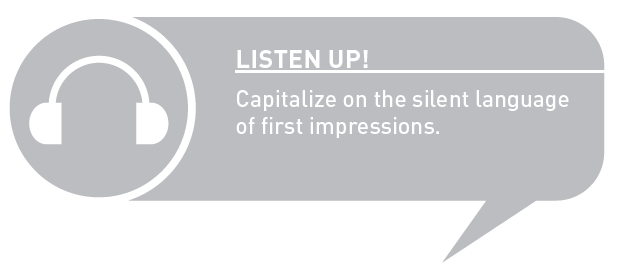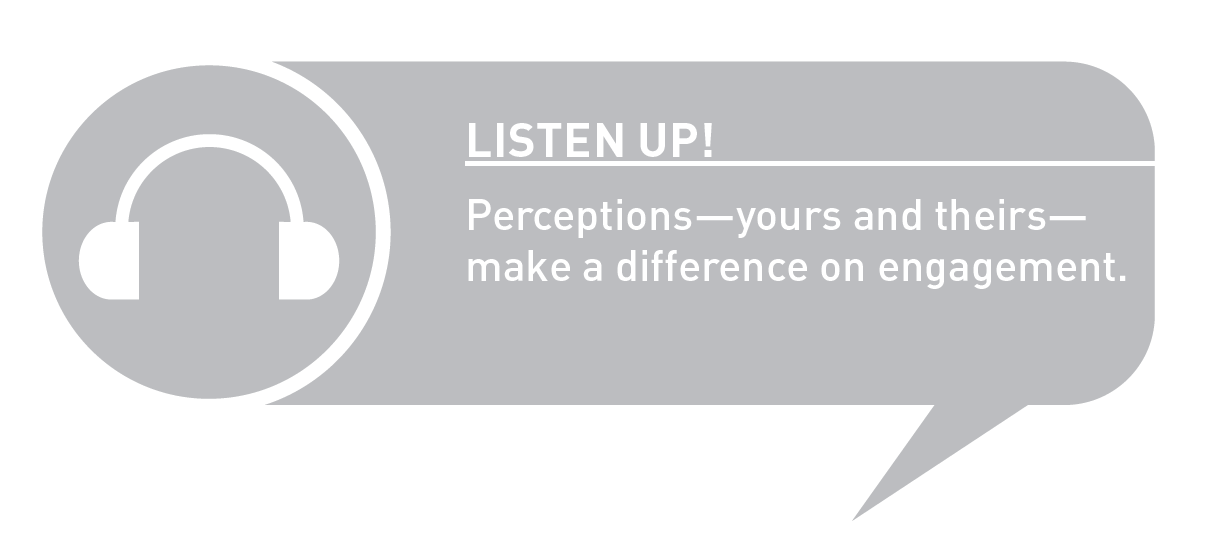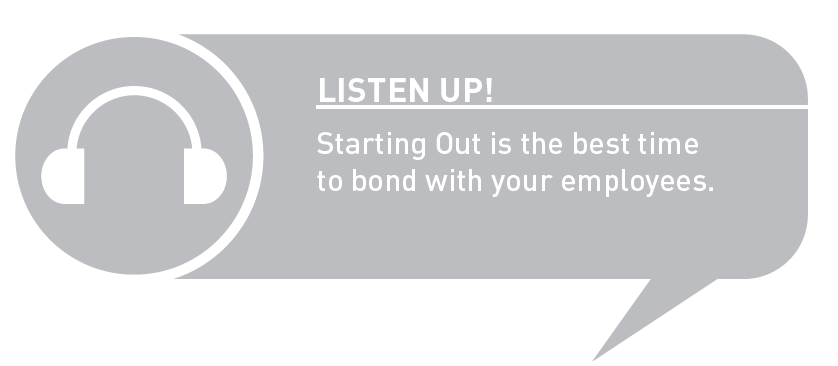Starting Out and Testing the Waters
Starting Out
Overview
This step is your golden opportunity as a manager to promote employee engagement because everything is new for the employee. He is hopeful, enthusiastic, and motivated about his new role and about the future. Similarly, you as a manager are confident about the employee’s role in the company and his potential contributions. The team members are also expectant about the opportunity to share the work with a new member; however, they are more cautious in their approach. Those first experiences of the new employee with the company, with the team, and with you are crucial because they alter the new employee’s perceptions about the workplace. What happens in this step will contribute to the employee’s level of engagement throughout his tenure at your company.

Now it’s your turn.
We would like you to begin to identify which step of the Engagement “I” Path employees are in. Who is in the Starting Out step? List the names of those employees in Worksheet 3.1.
Worksheet 3.1 Employees in the Starting Out Step
| STARTING OUT | EMPLOYEE NAMES |
|
|
|
|
|
|
|
|
We will now take a closer look at those engagement drivers that we introduced in chapter 1 and propose which ones are particularly important at this step.
Drivers
One of the drivers that we already discussed is organizational branding and image; it is important even before the employee joins the company because it is often what draws an employee to seek a position in that company. Base pay and incentive pay as well as overall benefits and flexible arrangements are part of the employment offer and together, they may persuade an employee to join a company. Total rewards, defined elsewhere in this book, will also play a key role in an employee’s decision.
Once the employee begins the Starting Out step, other drivers such as performance management, particularly objectives, communication, recognition, and autonomy will have some bearing on employee engagement as the new employee navigates around the organization. Likewise, organizational management in general will inspire the new employee to form those important bonds with the company, the manager, and the team, which will serve to anchor the emotional components of engagement. Finally, even though this step typically only includes the first six months of employment, the new employee will begin to gather information about career opportunities and potential; their availability will alter those initial perceptions as the new employee confirms the appropriateness of the decision to be part of the company.

We will now share with you some examples of employee behaviors that you may notice during the Starting Out step related to employee level of engagement and ask you to identify who is displaying them.
Employee Behaviors
These are some employee behaviors that you may observe during the Starting Out step.
- Observes how others behave to learn the unspoken codes of the workplace about issues such as bureaucracy, rules, regulations, rewards, and taboos.
- Obtains information about tasks and responsibilities as well as about goals and objectives.
- Establishes and executes work habits and routines.
- Seeks to establish relationships with others in the division and outside of it.
- Looks for similarities and differences between herself and others, including the manager.
- Identifies sources of information and support.
- Speaks highly about the company and team in social media and elsewhere.
- Begins to wear and display company logos and other symbols.
- Participates eagerly in the onboarding process to learn about the company.
- Validates if the organization’s values match his values.
- Pays attention to how leaders, particularly managers, communicate at all levels.
Now it’s your turn.
Select which behaviors from this list you have noticed among the employees who are in the Starting Out Step, using Worksheet 3.2.
Worksheet 3.2 Behaviors Observed From Employees in Starting Out Step
| BEHAVIORS | EMPLOYEE NAMES | ||
|---|---|---|---|
| Observes how others behave to learn the unspoken codes of the workplace about issues such as bureaucracy, rules, regulations, rewards, and taboos. |
|
|
|
| Obtains information about tasks and responsibilities as well as about goals and objectives. |
|
|
|
| Establishes and executes work habits and routines. |
|
|
|
| Seeks to establish relationships with others in the division and outside of it. |
|
|
|
| Looks for similarities and differences between herself and others, including the manager. |
|
|
|
| Identifies sources of information and support. |
|
|
|
| Speaks highly about the company and team in social media and elsewhere. |
|
|
|
| Begins to wear and display company logos and other symbols. |
|
|
|
| Participates eagerly in the onboarding process to learn about the company. |
|
|
|
| Validates if the organization’s values match his values. |
|
|
|
| Pays attention to how leaders, particularly managers, communicate at all levels. |
|
|
|
Manager Dos and Don’ts
Here are some examples of what you should and should not do when an employee is in the Starting Out step. We acknowledge that this list is extensive because of the importance of this step in the employee’s Engagement “I” Path. Please note that these dos and don’ts are not in any particular order.
Dos
- Ensure that basic equipment, tools, and resources are available prior to the new employee’s arrival.
- Meet with the team before the new employee arrives to prepare the team to welcome the new member.
- Introduce her to the team and others in the company promptly.
- Welcome the new employee personally.
- Provide information about the company, the job, and the team (onboarding).
- Prepare additional targeted onboarding activities to facilitate the new employee’s integration to the team.
- Model appropriate behaviors in the company (dress code, speech, ways of address, communication style, work ethic, traditions).
- Anticipate and remove barriers for employee’s success.
- Address issues with candor such as rumors, industry trends, reorganizations, promotions, and demotions, among others.
- Help the employee to understand business goals and the big picture as well as her contribution to the company’s bottom line.
- Specify and clarify roles, responsibilities, and expectations about yourself, the employee, the team, and others.
- Establish communication channels and frequency.
- Facilitate interactions with other departments and management.
- Provide timely and useful positive and developmental feedback.
- Respect the employee’s need for privacy by avoiding personal questions.
- Encourage questions and experimentation from the employee.
- Create a “safe environment.”
Don’ts
- Delay introductions to the team and to other members of the company.
- Procrastinate requesting basic equipment, tools, and resources for the new employee.
- Delegate welcoming and introducing the employee to another manager and department.
- Limit access of the employee to basic information about the company, the job, and the team.
- Demonstrate behaviors that are not consistent with the organizational image, values, and principles.
- Limit the onboarding process to what the company offers.
- Refuse to acknowledge and address issues such as rumors, industry trends, reorganizations, promotions, and demotions, among others.
- Leave expectations about the employee’s work undefined.
- Refuse to give clues and suggestions about what the employee should be doing in terms of integrating into the company.
- Point out cultural mistakes that resulted from not having the appropriate information beforehand.
- Delay answering questions promptly and with not enough information.
- Criticize in public.
- Provide double messages (for example, encourage experimentation, but penalize for mistakes).
- Show favoritism in the team.
- Take questions personally.
- Be too personal.

Now it’s your turn.
Worksheet 3.3 presents a behavior self-assessment for you to identify those behaviors that you have displayed or that you display typically. Place a check mark on the right column to indicate if you display those behaviors, you do not display them, or you display them sometimes.
Worksheet 3.3 Manager Behavior Self-Assessment: Starting Out Step
| BEHAVIOR | YES | NO | SOMETIMES |
| DOS: | |||
| Ensure that basic equipment, tools, and resources are available prior to the new employee’s arrival. | |||
| Meet with the team before the new employee arrives to prepare the team to welcome the new member. | |||
| Introduce her to the team and others in the company promptly. | |||
| Welcome the new employee personally. | |||
| Provide information about the company, the job, and the team (onboarding) | |||
| Prepare additional targeted onboarding activities to facilitate the new employee’s integration to the team. | |||
| Model appropriate behaviors in the company (dress code, speech, ways of address, communication style, work ethic, traditions). | |||
| Anticipate and remove barriers for employee’s success. | |||
| Address issues with candor such as rumors, industry trends, reorganizations, promotions, and demotions, among others. | |||
| Help the employee to understand business goals and the big picture as well as her contribution to the company’s bottom line. | |||
| Specify and clarify roles, responsibilities, and expectations about yourself, the employee, the team, and others. | |||
| Establish communication channels and frequency. | |||
| Facilitate interactions with other departments and management. | |||
| Provide timely and useful positive and developmental feedback. | |||
| Respect the employee’s need for privacy by avoiding personal questions. | |||
| Encourage questions and experimentation from the employee. | |||
| Create a “safe environment.” | |||
| DON’TS: | |||
| Delay introductions to the team and to other members of the company. | |||
| Procrastinate requesting basic equipment, tools, and resources for the new employee. | |||
| Delegate welcoming and introducing the employee to another manager and department. | |||
| Limit access of the employee to basic information about the company, the job, and the team. | |||
| Demonstrate behaviors that are not consistent with the organizational image, values, and principles. | |||
| Limit the onboarding process to what the company offers. | |||
| Refuse to acknowledge and address issues such as rumors, industry trends, reorganizations, promotions, and demotions, among others. | |||
| Leave expectations about the employee’s work undefined. | |||
| Refuse to give clues and suggestions about what the employee should be doing in terms of integrating into the company. | |||
| Point out cultural mistakes that resulted from not having the appropriate information beforehand. | |||
| Delay answering questions promptly and with not enough information. | |||
| Criticize in public. | |||
| Provide double messages (for example, encourage experimentation, but penalize for mistakes). | |||
| Show favoritism in the team. | |||
| Take questions personally. | |||
| Be too personal. |
-
How many are dos and how many are don’ts?
-
Identify the three don’ts that you would like to turn into dos.
-
Identify the behaviors that you do sometimes and explain why you do so.
Testing the Waters
Overview
This step is your opportunity to continue to increase the engagement of that employee who has been a member of your team for the last six months. At this time, the employee validates if the decision to join the company was correct based on how well he fits with the company and its values. Questions such as, “Is this the right place for me?” “Is this place for real?” “What happened to the promises?” or “Where’s the gold?” will be in the employee’s mind as he seeks information. At the same time, you as a manager will be looking for signals that you made the correct decision to bring this employee into the company. By now, you have had some time to evaluate his capacity to contribute, adapt, and adjust to the team through the results that you have begun to see.
Now it’s your turn.
Who is in the Testing the Waters step? List the names of those employees who are at this step in Worksheet 3.4.
Worksheet 3.4 Employees in the Testing the Waters Step
| TESTING THE WATERS | EMPLOYEE NAMES |
|
|
|
|
|
|
|
|
Drivers
At this step, the focus is less on image and more on alignment as the employee assesses how she fits in the new setting. The meaning of total rewards changes as she becomes more familiar with the new workplace and obtains firsthand information about those rewards. In this step, since the initial onboarding process has ended, the employee begins to experience the type of work and the size of the workload and can reach conclusions about the existent level of autonomy on the job. As she executes and completes tasks, she gets a sense of competence and progress as she finds meaning in the work (that is, intrinsic motivation). She gains insights into the flexibility of work arrangements, issues entailing work-life balance, and workplace stress through the communication and behaviors of the organization’s leaders, particularly in terms of performance management. The respect and quality of co-workers gains sizeable importance as the employee interacts more closely with them and continues to seek information about the workplace and those unwritten rules that must be followed for success. In many instances, the employee looks for an environment conducive to good service to others. Potential career opportunities are a significant issue in the Testing the Waters step as the employee obtains information about what could be available for her in the future.
Following are some examples of employee behaviors that you may notice during the Testing the Waters step that relate to employee level of engagement. Then we’ll ask you to identify who is displaying them.
Employee Behaviors
These are some employee behaviors that you may observe during the Testing the Waters step.
- Seeks additional assignments and challenges to demonstrate skills.
- Seeks reasons to work beyond external rewards.
- Completes tasks and tests the system to find out what can and cannot be done.
- Evaluates how much autonomy and flexibility is available to complete tasks.
- Delves into the relationship with the team.
- Assesses the quality of the interactions and calibrates how much he can trust others.
- Searches for opportunities to expand her internal network.
- Demonstrates that he is beginning to form a more realistic opinion of the company’s or division’s virtues and areas of opportunity.
- Detects inconsistencies between what the company presents to outsiders and what the company is really about; evaluates brand alignment.
- Asks a lot of questions.
- Compares the type of work, size of workload, and classes of rewards available to different team members.
- Incorporates suggestions into her work.
- Searches for opportunities to begin to contribute and for ways those contributions can noticed and acknowledged.

Now it’s your turn.
Select which behaviors from this list you have noticed among the employees who are in the Testing the Waters step in Worksheet 3.5.
Worksheet 3.5 Behaviors Observed From Employees in the Testing the Waters Step
| BEHAVIORS | EMPLOYEE NAMES | ||
| Seeks additional assignments and challenges to demonstrate skills. | |||
| Seeks reasons to work beyond external rewards. | |||
| Completes tasks and tests the system to find out what can and cannot be done. | |||
| Evaluates how much autonomy and flexibility is available to complete tasks. | |||
| Delves into the relationship with the team. | |||
| Assesses the quality of the interactions and calibrates how much he can trust others. | |||
| Searches for opportunities to expand her internal network. | |||
| Demonstrates that he is beginning to form a more realistic opinion of the company’s or division’s virtues and areas of opportunity. | |||
| Detects inconsistencies between what the company presents to outsiders and what the company is really about; evaluates brand alignment. | |||
| Asks a lot of questions. | |||
| Compares the type of work, size of workload, and classes of rewards available to different team members. | |||
| Incorporates suggestions into her work. | |||
| Searches for opportunities to begin to contribute and for ways those contributions can be noticed and acknowledged. | |||
Manager Dos and Don’ts
Now that you are more familiar with your employee’s experience during the Testing the Waters step, we suggest some actions for you to take and avoid to promote employee engagement during this step. As before, please note that these dos and don’ts are not in any particular order.
Dos
- Coach the employee on how to approach different situations.
- Answer questions and allow experimentation from the employee.
- Create a “safe environment” to stretch talents and make mistakes.
- Conduct “reality checks” for expectations, role, and career.
- Communicate, communicate, communicate.
- Avoid criticism and sarcasm.
- Model appropriate behaviors in the company (dress code, speech, ways of address, communication style, work ethic, traditions).
- Anticipate barriers for the employee’s success.
- Provide timely and useful positive and developmental feedback.
- Handle performance issues fairly and equitably (workload, work-life balance, performance management).
- Be fair and honest.
Don’ts
- Miss opportunities to coach the employee on important issues or assignments.
- Minimize the importance of the employee for the company and the team.
- Show favoritism in the team.
- Be secretive about information that can be shared.
- React to problems instead of anticipating them.
- Only point out mistakes and faults.
- Ignore positive or appropriate actions and behaviors.
- Delay positive and developmental feedback until formal performance reviews.
- Wait for the employee to make mistakes that could have been avoided and then reprimand the employee for those mistakes.
Now it’s your turn.
Worksheet 3.6 presents a behavior self-assessment for you to identify those behaviors that you have displayed or that you display typically. Place a check mark on the right column to indicate if you display those behaviors, you do not display them, or you display them sometimes.
Worksheet 3.6 Manager Behavior Self-Assessment: Testing the Waters Step
| BEHAVIOR | YES | NO | SOMETIMES |
|
DOS: |
|||
| Coach the employee on how to approach different situations. | |||
| Answer questions and encourage experimentation from the employee. | |||
| Create a “safe environment” to stretch talents and make mistakes. | |||
| Conduct “reality checks” for expectations, role, and career. | |||
| Communicate, communicate, communicate. | |||
| Avoid criticism and sarcasm. | |||
| Model appropriate behaviors in the company (dress code, speech, ways of address, communication style, work ethic, traditions). | |||
| Anticipate barriers for the employee’s success. | |||
| Provide timely and useful positive and developmental feedback. | |||
| Handle performance issues fairly and equitably (workload, work-life balance, performance management). | |||
| Be fair and honest. | |||
|
DON’TS: |
|||
| Miss opportunities to coach the employee on important issues or assignments. | |||
| Minimize the importance of the employee for the company and the team. | |||
| Show favoritism in the team. | |||
| Be secretive about information that can be shared. | |||
| React to problems instead of anticipating them. | |||
| Only point out mistakes and faults. | |||
| Ignore positive or appropriate actions and behaviors. | |||
| Delay positive and developmental feedback until formal performance reviews. | |||
| Wait for the employee to make mistakes that could have been avoided and then reprimand the employee for those mistakes. |
-
How many are dos and how many are don’ts?
-
Identify the three don’ts that you would like to turn into dos.
-
Identify the behaviors that you do sometimes and explain why you do so.
In the next chapter we will explore the next two steps in the Engagement “I” Path: the Stable step, and the Critical Incident step.
